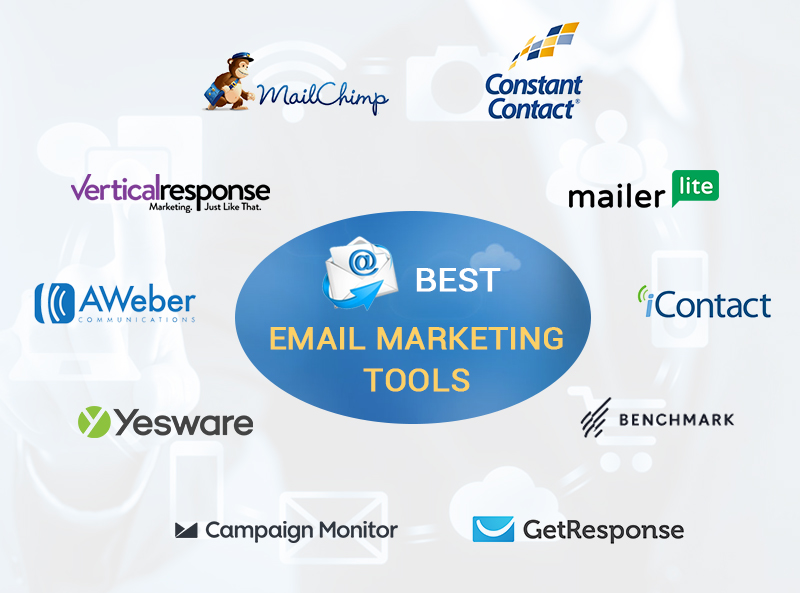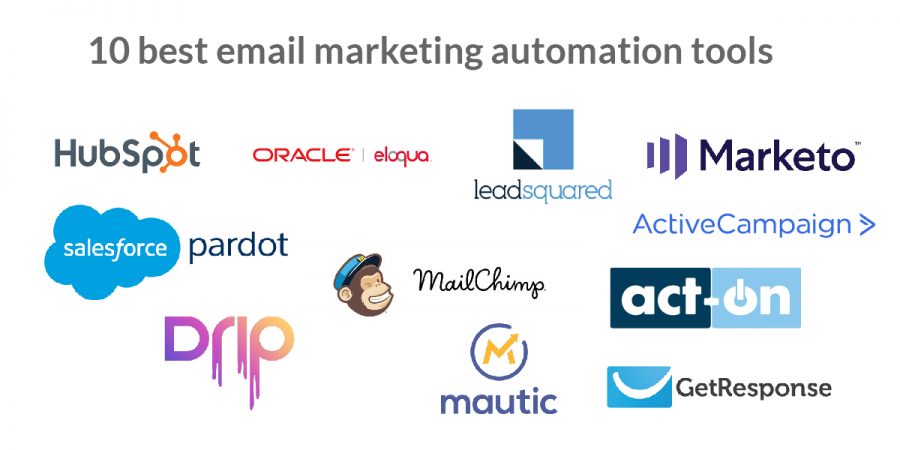Email marketing is a powerful way to reach customers. Finding the right tool can make a big difference.
In today’s digital age, email marketing stands out as a vital strategy for businesses. From small startups to large corporations, everyone needs an efficient way to communicate with their audience. With countless tools available, choosing the best one can feel overwhelming.
The right email marketing tool can streamline your campaigns, improve engagement, and boost your bottom line. But not all tools are created equal. Some offer features that others lack, and each has its strengths and weaknesses. This blog post will guide you through what to look for in an email marketing tool. By the end, you’ll know which one suits your needs best.

Credit: kvrwebtech.com
Introduction To Email Marketing Tools
Email marketing tools are essential for businesses seeking to engage their audience. These tools help create, manage, and track email campaigns effectively. With various features, they simplify the process, making it more efficient and impactful.
Importance Of Choosing The Right Tool
Choosing the right email marketing tool can determine your campaign’s success. The right tool provides features that align with your business needs.
Here’s why selecting the right tool is crucial:
- Automation: Automate emails to save time and effort.
- Personalization: Personalized emails increase engagement rates.
- Analytics: Track and measure campaign performance.
These features can enhance your marketing efforts. They make your campaigns more effective and targeted.
Impact On Campaign Success
The right tool has a direct impact on campaign success. It helps you reach your audience more effectively.
Consider the following impacts:
- Higher Open Rates: Well-crafted emails lead to higher open rates.
- Better Engagement: Engaging content boosts interaction with your emails.
- Conversion Rates: Effective tools improve conversion rates.
These benefits contribute to overall business growth. They ensure your marketing efforts yield better results.
Below is a comparison table of some popular email marketing tools:
| Tool Name | Best Features | Pricing |
|---|---|---|
| Mailchimp | Automation, Analytics, Templates | Free and Paid plans |
| Constant Contact | Easy to Use, Support, Integrations | Paid plans |
| Sendinblue | Transactional Emails, SMS Marketing | Free and Paid plans |
Key Features To Look For
Choosing the right email marketing tool can be overwhelming. Knowing the key features can help you make the best choice. Here are some of the most important features to consider.
Automation Capabilities
Automation can save you a lot of time. Look for tools that offer the following:
- Automated email sequences
- Triggered emails based on user actions
- Drip campaigns
- Autoresponders
These features allow you to send the right message at the right time. Automated emails can also improve engagement and conversion rates.
Segmentation And Targeting
Segmentation helps you target specific groups. This makes your emails more relevant. Look for tools that offer:
- List segmentation based on user behavior
- Custom tags and fields
- Dynamic content based on user data
Targeted emails have higher open rates and click-through rates. Segmentation allows you to deliver personalized content to your audience.
Analytics And Reporting
Understanding your email performance is crucial. Look for tools that offer:
- Detailed analytics on open and click rates
- A/B testing capabilities
- Conversion tracking
- Real-time reporting
These features help you measure success and make data-driven decisions. Good analytics can show you what works and what needs improvement.
Top Email Marketing Tools
Choosing the best email marketing tool can be challenging. There are many options with different features. Here are the top email marketing tools to help you decide.
Tool A Overview
Tool A is known for its user-friendly interface. It offers:
- Easy-to-use drag-and-drop editor
- Automated email sequences
- Detailed analytics
Pros:
- Simple setup
- Good customer support
- Affordable pricing
Cons:
- Limited customization options
- Basic templates
Tool B Overview
Tool B is ideal for businesses of all sizes. Key features include:
- Advanced segmentation
- Personalized content
- Integration with CRM tools
Pros:
- Highly customizable
- Robust analytics
- Strong integration capabilities
Cons:
- Steeper learning curve
- Higher cost for advanced features
Tool C Overview
Tool C excels in automation and design. Notable features are:
- Pre-built automation workflows
- Responsive email templates
- A/B testing
Pros:
- Great for beginners
- Visually appealing templates
- Strong support community
Cons:
- Limited advanced features
- More expensive than some alternatives

Credit: www.linkedin.com
Comparing Pricing Plans
Choosing the right email marketing tool involves understanding the cost implications. Different tools offer various pricing plans, which can influence your decision. Let’s compare these plans to help you choose the best email marketing tool for your needs.
Free Vs Paid Plans
Most email marketing tools provide free plans with basic features. These plans are suitable for small businesses or beginners. They usually include:
- Limited subscribers (up to 500 or 1,000)
- Basic templates
- Simple analytics
On the other hand, paid plans offer more advanced features. These are ideal for growing businesses or those needing more functionality. Paid plans often include:
- Unlimited subscribers
- Advanced templates and customization
- Detailed analytics and reporting
- Automation and segmentation
Cost-effectiveness
Cost-effectiveness depends on your business size and goals. Free plans can save money if you are just starting. But paid plans can offer better value as your business grows. Consider these factors:
- Budget: How much can you afford monthly?
- Features: Which features are essential for your campaigns?
- Growth: How fast do you expect your subscriber list to grow?
Sometimes, investing in a paid plan early can save money in the long run. This is especially true if it helps you increase sales and engagement.
Scalability
Scalability is crucial for a growing business. You need an email marketing tool that grows with your business. Look for tools that offer:
- Easy upgrade options
- Flexible pricing tiers
- Advanced features for larger campaigns
Some tools charge based on subscriber count. Others charge based on the number of emails sent. Choose a plan that aligns with your growth trajectory.
Here is a table comparing popular email marketing tools:
| Tool | Free Plan | Paid Plan Starts At | Key Features |
|---|---|---|---|
| Mailchimp | Yes | $9.99/month | Automation, A/B testing, Analytics |
| Constant Contact | No | $20/month | Event marketing, Surveys, Custom templates |
| Sendinblue | Yes | $25/month | SMS marketing, CRM, Advanced segmentation |
Evaluate your needs and budget. Then choose the plan that offers the best value for your business.
User Experience And Interface
Choosing the right email marketing tool requires evaluating its user experience and interface. A tool should be easy to navigate and customize. It should offer robust customer support to address any issues quickly. Let’s explore these aspects in detail.
Ease Of Use
An email marketing tool should have an intuitive design. Users should find it easy to create and send emails. The dashboard should be clean and straightforward. Important features should be accessible with minimal clicks. A simple drag-and-drop editor can make email creation faster.
Customization Options
Customization is crucial for effective email marketing. A good tool should offer a variety of templates. Users should be able to customize these templates to match their brand. Key elements include:
- Text formatting: Choose different fonts and sizes.
- Image uploads: Add and edit images easily.
- Color schemes: Match your brand’s colors.
- CTA buttons: Customize call-to-action buttons.
Advanced tools may offer segmentation features. This allows for targeted email campaigns. Personalization options, such as dynamic content, enhance user engagement.
Customer Support
Reliable customer support is essential. Look for tools that offer multiple support channels:
- Email support
- Live chat
- Phone support
- Comprehensive knowledge base
Quick and effective support can resolve issues efficiently. Some tools offer dedicated account managers for premium users. This can be beneficial for large-scale campaigns.
In summary, the best email marketing tools excel in user experience and interface. They are easy to use, highly customizable, and backed by robust customer support.
Integration With Other Platforms
Email marketing is more effective when it integrates with other platforms. This synergy enhances functionality and provides a seamless experience. Learn how the best email marketing tools can integrate with your CRM, social media, and e-commerce platforms.
Crm Integration
Integrating your email marketing tool with your Customer Relationship Management (CRM) system is crucial. It allows you to sync customer data, making it easier to personalize emails. This integration ensures that all customer interactions are recorded in one place.
Here are some benefits of CRM integration:
- Automated Data Sync: Updates customer information in real-time.
- Personalized Campaigns: Tailors emails based on customer behavior.
- Improved Analytics: Tracks email performance within the CRM.
Social Media Integration
Social media integration enhances your email marketing strategy. It helps you reach a wider audience and engage with them on multiple platforms. This integration allows you to share email campaigns on social media, increasing visibility.
Key benefits include:
- Cross-Platform Campaigns: Share email content on social media.
- Audience Growth: Attract new followers and subscribers.
- Enhanced Engagement: Interact with users on various platforms.
E-commerce Integration
E-commerce integration is essential for online stores. It allows you to sync your email marketing tool with your e-commerce platform. This integration helps in sending personalized product recommendations and cart recovery emails.
Benefits of e-commerce integration:
- Product Recommendations: Send tailored product suggestions.
- Cart Recovery: Remind customers of abandoned carts.
- Sales Tracking: Monitor sales from email campaigns.
Case Studies And Success Stories
Case studies and success stories help illustrate the real-world impact of email marketing tools. These stories show how different organizations, whether small businesses, enterprises, or non-profits, have effectively used email marketing to achieve their goals. Let’s explore some inspiring examples.
Small Business Success
A local bakery wanted to boost its customer loyalty. They used an email marketing tool to send personalized birthday discounts. This tactic increased repeat visits by 30%. The tool’s automation feature saved time and ensured timely delivery of emails. Small changes made a big difference.
Enterprise Success
A large retail chain struggled with abandoned carts. They used an email marketing tool to automate follow-up emails. These emails included a link to the cart and a small discount. This approach recovered 20% of lost sales. The tool’s analytics helped refine their strategy over time.
Non-profit Success
A non-profit organization aimed to increase donor engagement. They segmented their email list based on donor history. Personalized emails shared success stories and upcoming events. This strategy led to a 25% increase in donations. The tool’s reporting features helped track progress and adjust campaigns.
These case studies highlight the versatility and effectiveness of email marketing tools. Small businesses, large enterprises, and non-profits can all benefit from these powerful tools.
Tips For Maximizing Tool Potential
Email marketing tools can transform how you connect with your audience. To get the most from these tools, you need to know some key strategies. Using these tips, you can boost your email marketing efforts.
A/b Testing
A/B testing helps you understand what works best. Create two versions of your email. Change one element, such as the subject line or call-to-action. Send each version to a small group of your audience. Analyze which performs better. Then, send the winning version to the rest of your list. This method increases your email effectiveness.
Personalization Techniques
Personalization makes your emails feel unique. Use the recipient’s name in the subject line or greeting. Segment your audience based on their interests or behavior. Send tailored content that matches their preferences. This approach makes your emails more engaging and relevant. Personalized emails often have higher open and click rates.
List Management
Good list management is crucial for email marketing success. Keep your list clean and up-to-date. Remove inactive subscribers regularly. Use double opt-in to ensure your list is full of engaged users. Segment your list to send targeted emails. Proper list management improves deliverability and engagement.
Conclusion And Recommendations
Concluding our guide on the best email marketing tool is essential. Making the right choice can boost your email campaigns. It helps build better connections with your audience. Let’s summarize key points and offer some final thoughts.
Choosing The Best Tool
Selecting the best email marketing tool depends on your needs. Consider the following factors:
- Budget: Check the pricing plans. Choose one that fits your budget.
- Features: Look for features like automation, templates, and analytics.
- Ease of Use: The tool should be easy to use. It should not require technical skills.
- Integration: Ensure the tool integrates with your existing software.
- Customer Support: Good support can help resolve issues quickly.
Future Trends In Email Marketing
Staying updated with trends helps keep your campaigns effective. Here are some future trends:
- AI and Machine Learning: These technologies will personalize emails more. They will analyze data to predict user behavior.
- Interactive Emails: Expect more interactive elements. Think of polls, surveys, and carousels within emails.
- Mobile Optimization: More people check emails on mobile. Ensure your emails are mobile-friendly.
- Privacy and Data Protection: New regulations will focus on user privacy. Ensure your tool complies with these laws.
Choosing the right tool and staying updated with trends is vital. It ensures your email marketing remains effective and engaging.

Credit: telloquent.com
Frequently Asked Questions
What Is The Best Email Marketing Tool?
The best email marketing tool varies based on needs. Popular options include Mailchimp, Constant Contact, and Sendinblue. Each offers unique features.
How Do I Choose An Email Marketing Tool?
Consider factors like ease of use, automation features, pricing, and customer support. Check for integrations with other software.
Are Email Marketing Tools Worth The Cost?
Yes, email marketing tools save time and improve campaign effectiveness. They offer automation, analytics, and better audience targeting.
Can Email Marketing Tools Improve Engagement?
Absolutely, these tools help personalize content, schedule emails, and analyze performance. This leads to higher engagement rates.
Conclusion
Choosing the right email marketing tool is crucial for your business. It can boost engagement and drive sales. Evaluate your needs and budget before deciding. Test different tools to find the best fit. Remember, the best tool simplifies tasks and saves time.
Start small and scale as you grow. Consistent effort leads to better results. Stay updated with trends and adapt quickly. Happy emailing!


Leave a Reply